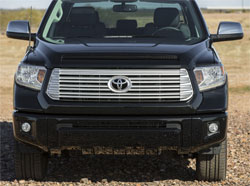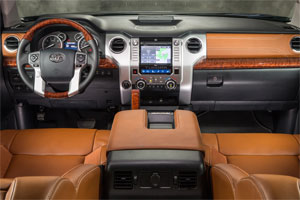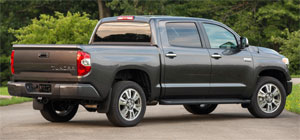2014 Toyota Tundra
When the Tundra replaced the T100 in the Toyota lineup for 2000, it was proof that Toyota was serious about taking on the domestics in the full-size pickup truck market. And while sales have never really challenged F150 or Silverado, the Tundra has carved quite a niche for itself among personal use buyers. Now let’s see if a new manly makeover will help them carve out even more sales.
It’s hard to ignore the 2014 Toyota Tundra’s changed face. It’s larger and more in your face, and in tune with the more rugged appearance that graces the rest of the truck. And that more macho design was by design.
Despite being just as capable as domestic light-duty pickups, the Tundra has thus far been unable to shed its soft image. Well, as truck current marketing-think goes; the bigger the grille, the more capable the truck! So the new Tundra’s cow catcher grows in size, yet still blends in nicely with a new 3-piece front bumper.
 The stance is certainly wider, and fenders are a little more squared off, all helping to reaffirm this Tundra’s credentials, as does towing up to 10,400-pounds. The rear end is “branded” with Tundra script; an integrated tailgate spoiler, and a 3-piece bumper of its own, while aero tricks on the rear tail light lenses and side mirrors help this brutish brick get through the air as efficiently as possible.
The stance is certainly wider, and fenders are a little more squared off, all helping to reaffirm this Tundra’s credentials, as does towing up to 10,400-pounds. The rear end is “branded” with Tundra script; an integrated tailgate spoiler, and a 3-piece bumper of its own, while aero tricks on the rear tail light lenses and side mirrors help this brutish brick get through the air as efficiently as possible.
To keep pace with the high dollar pickups now in vogue, Toyota adds a new 1794 model that pegs the bling-o-meter with 20-inch alloy wheels and a power moon roof. 3-Cabs are available; the 2-door Regular cab and a pair of 4-doors – the extended Double cab, and the CrewMax crew cab with a standard power sliding back window. All Tundras add Halogen reflector beam headlights with manual level control; and the 1794 edition adds LED daytime running lights.
We are disappointed to see no major powertrains changes, however. It’s not that they’re inadequate. But, domestic full-size pickups, along with Nissan’s Titan, are making some serious strides in mixing more power with more fuel economy and Toyota is at risk of getting left behind.
As before, a 4.0-liter V6 is the base engine, and a pair of V8’s are available. We spent most of our time in the volume leading 5.7-liter V8 rated at 381-horsepower, and 401 lb-ft. of torque. While it pulls strongly and has a very responsive throttle, compared to domestic V8’s it tends to sound like it’s working much too hard.
It’s paired with a 6-speed automatic transmission with tow/haul mode, and gets Government Fuel Economy Ratings of 13-City, 17-Highway, and 15-Combined for our 4-wheel-drive tester. That makes for a very poor Energy Impact Score thanks to 22.0-barrels of annual oil consumption and yearly CO2 emissions of 10.0-tons.
 While the exterior has undeniably taken the macho route, the interior has actually gotten even friendlier. Materials vary greatly with trim level, but our CrewMax Limited had very comfortable leather clad seats and wood-style trim. Also, Tundra is the only truck with available blind-spot monitoring and rear cross traffic alert. CrewMax models offer plenty of room in the rear seats as well, whether left in place for seating, or folded up out of the way for cargo. Switchgear is nice and big, with a fairly logical layout; and major controls are closer to the driver than before for ease of use.
While the exterior has undeniably taken the macho route, the interior has actually gotten even friendlier. Materials vary greatly with trim level, but our CrewMax Limited had very comfortable leather clad seats and wood-style trim. Also, Tundra is the only truck with available blind-spot monitoring and rear cross traffic alert. CrewMax models offer plenty of room in the rear seats as well, whether left in place for seating, or folded up out of the way for cargo. Switchgear is nice and big, with a fairly logical layout; and major controls are closer to the driver than before for ease of use.
One complaint; like most rivals the Tundra’s navigation screen is hard to read in direct sunlight. The Tundra’s frame also carries over from last year, but the suspension has been revised and an improvement is quickly noticed. Ride quality is smoother and you really feel like you’re riding high and breathing thin air. Steering remains hydraulic, providing good overall feel, with better straight line stability.
 During our limited off pavement time we found the Tundra to be plenty capable of handling the less traveled way to your favorite camp site or hunting spot; and engaging 4-wheel-drive on the fly was quick and smooth. An automatic limited-slip differential is standard.
During our limited off pavement time we found the Tundra to be plenty capable of handling the less traveled way to your favorite camp site or hunting spot; and engaging 4-wheel-drive on the fly was quick and smooth. An automatic limited-slip differential is standard.
And when it comes to pricing, starting at just $26,915 the Toyota Tundra is a lot of truck for the money. The 2014 Toyota Tundra has improved greatly and without a doubt has proved itself to be a viable alternative to the Big-3. Still, in this full-size arena, the domestics do it better. However, while Ford, Chevrolet, and RAM may not be worried at the moment; the Tundra is here to stay, and it’s getting better all the time.
Specifications
- Engine: 5.7-liter V8
- Horsepower: 381
- Torque: 401 lb-ft.
- EPA: 13 mpg city/ 17 mpg highway
- Energy Impact: 22.0 barrels of oil/yr
- CO2 Emissions: 10.0 tons/yr
2025 Infiniti QX80
Infiniti’s Flagship SUV Sets A Course For Extravagance
This full-size Infiniti QX80 started out as the QX56, a hastily rebadged version of Nissan’s truck-based Armada full-size utility. That was in the early 2000s when the luxury SUV craze was exploding. It wasn’t as much as a game-changer, as it was “try to keep upper”. Now, this new QX80, Infiniti is promising to “Reimagine the luxury SUV”. Let’s see if Infiniti has turned their imaginations into reality.
Well, if over the top is what Infiniti was shooting for in the all-new 2025 QX80, mission accomplished. There’s an overall feeling of extravagance here that we haven’t experienced from Infiniti in quite some time.
It’s not just the open pore ash wood trim with aluminum inlays, 24-speaker audio, and plush quilted leather seating; there’s also nicely integrated ambient lighting, a massive glass roof, plenty of tech, lots of active driving assistance, and even chilled center console storage. Forward of that is a dual touchscreen setup; the top 14.3-inch touchscreen for infotainment sits next to the digital gauge display in a single housing; while just below, there’s a 9-inch one for climate controls.
You are reminded this is still a body-on-frame utility the moment you have to climb up into the cockpit, but there’s also the commanding view of the road that comes with that. Captain’s chairs are standard for the second row, but a three-place bench is optional with all trims except for top Autograph which comes exclusively with these climate-controlled massaging chairs, along with a touchscreen control panel. The third-row experience is great, too, with heated leather seating, and adult size room for three.
Now, there is a whole new experience coming from under the hood. The last gen’s V8 has been replaced with a new twin-turbo 3.5-liter V6 rated at 450 horsepower, 50 over the V8. More notably, torque is up by more than 100 lb-ft to 516. Transmission is a nine-speed automatic, two more gears than last year, with rear-wheel drive standard, four-wheel drive an option. Max tow rating is 8,500-lbs.
And at the test track, it did pull strongly off the line, getting up to speed in a hurry with the 0-60 sprint taking just 6.3 seconds. There is roughly 3 tons of weight to push through the quarter-mile, but that twin-turbo does it well, finishing in 14.7 seconds at 95 mph. Gear changes are incredibly smooth, while not hindering acceleration in any way.
It's an impressive looking utility from any angle.
In panic braking runs, there was some fade and a considerable amount of nosedive, but our average stopping distance of 115 feet is not bad for a vehicle as big and heavy as the QX80. Last gen, the QX80 moved from the Titan truck platform to the global Patrol SUV chassis, which shifted the vibe from budget Escalade to Lexus LX fighter. The attending improvement in ride and handling was the real bonus, and that largely continues for this gen with air suspension and Dynamic Digital Dampers on all but base QX80s. While we could certainly feel all that weight through our cone course, body roll was well-controlled and without significant oversteer or understeer.
It’s an impressive looking utility from any angle, starting right up front with the big “bamboo forest” grille. The overall shape is boxy, but all body panels are smooth; and for better or worse, Infiniti joins the flush door handle fad. Look for its “Artistry In Motion” design theme to work its way down through the rest of the Infiniti lineup. All QX80s ride on 22-inch wheels except for base Pure trim which makes do with 20s.
A full power play includes standard motion-activated rear liftgate and power operation of both second and third row seats, expanding cargo capacity from 22 cu-ft behind the third row to 59 behind the second, and a max of 101.0 cu-ft with both rows folded.
Government Fuel Economy Ratings with four-wheel-drive are not great: 16 city, 19 highway and 17 combined. We averaged 18.6 mpg of premium. That’s a much worse than average Energy Impact Score, using 17.5 barrels of oil annually, with 8.6 tons of CO2 emissions.
Driving such a PUREly LUXEurious SENSORY overload, you’ll probably be expecting people to want your AUTOGRAPH, which we’re guessing is how Infiniti came up with their grade structure; pricing starts with Pure at $84,445 and climbs to $112,590 for Autograph.
The 2025 Infiniti QX80 is a massive SUV that delivers massive amounts of power and luxury. They aimed for the moon here and have clearly blasted themselves into a much more competitive orbit in the big buck, big hauler, sport-utility galaxy.
Specifications
As Tested
- Engine: 3.5-liter twin-turbo V6
- Transmission: 9-speed automatic
- Horsepower: 450
- Torque: 516 lb-ft.
- EPA: 16 City | 19 Highway | 17 Combined
- 0-60 mph: 6.3 seconds
- 1/4 Mile: 14.7 seconds at 95 mph
- Braking, 60-0 (avg.): 115 feet
- MW Fuel Economy: 18.6 mpg (Premium)
























































